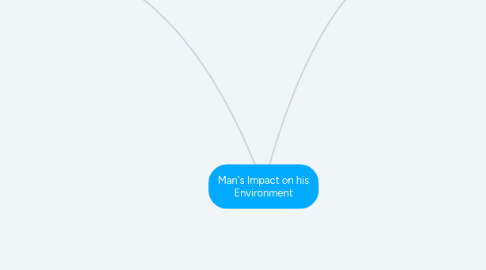
1. Negative
1.1. Depletion of natural resources
1.1.1. Fossil Fuels
1.1.1.1. Cannot be replaced quickly once depleted
1.1.2. Metals, Minerals
1.1.2.1. Cannot be replaced when they are removed from the ground
1.1.3. Wood
1.1.3.1. When the number of trees cut down is more than the number of trees replaced, forests can become depleted
1.1.4. Food Sources
1.1.4.1. When the number of fish caught is greater than the number of fish replaced, the population of fish will decrease over time. As a result, some species of fish will become endangered or extinct
1.2. Pollution
1.2.1. Waste
1.2.1.1. When waste breaks down, it gives off bad-smelling gases. If waste catches fire, it may give off poisonous gases which are bad for health
1.2.2. Harmful Chemicals
1.2.2.1. Chemicals in factory waste, pesticides, fertilizers and oil that are discharged into water bodies will pollute our water, making the water unsafe for use. If these substances get into the bodies of organisms, the organisms might get poisoned or even die
1.2.3. Smoke
1.2.3.1. Harmful gases in smoke can dissolve in rainwater to form acid rain. Acid rain can damage buildings and structures made of stone and metal. Acid rain is also harmful to living things. It can cause trees to die. When acid rain gets into water bodies, it can kill the organisms living in the water
1.2.4. Haze
1.2.4.1. Haze occurs when there is too much dust or smoke in the air. This can harm our health as well as affect how clearly we can see
1.2.5. CFCs
1.2.5.1. CFCs can thin the ozone layer, allowing more UV rays from the Sun to reach the Earth. These UV rays can cause sunburns, eye problems and even skin cancer. They can also kill plants
1.2.6. Air
1.2.7. Water
1.3. Global Warming
1.3.1. Droughts
1.3.2. Floods
1.3.3. Ice melting in some parts of the world and sea level rising
1.3.4. When there is more carbon dioxide in the air, more heat is trapped on the Earth, causing the average temperature of the Earth to rise
1.4. Deforestation
1.4.1. Organisms living in the affected forest may die due to habitat loss
1.4.2. The amount of carbon dioxide in the air increases as there are fewer trees to take in carbon dioxide during photosynthesis
1.4.3. The land becomes dry due to less rainfall as fewer trees give out water vapor to the air. Less clouds are formed and hence the amount of rain decreases
1.4.4. The soil becomes more easily removed by wind or water, as there are fewer trees to hold onto the soil. This can result in soil erosion. When the soil is washed into water bodies, organisms in the polluted water may not be able to survive
2. Positive
2.1. Conservation of Natural Resources
2.1.1. Reusing, reducing and recycling materials
2.1.1.1. Conserve natural resources (Materials such as plastic, paper, glass and metal)
2.1.2. Reducing land, water and air pollution
2.1.2.1. Dispose rubbish properly
2.1.2.2. Travelling by public transport
2.1.3. Protecting wildlife
2.1.3.1. To ensure that there will always be a diversity of living things on Earth
2.1.3.2. Protecting natural habitats such as seas and forests
2.1.3.3. Set up more nature parks to encourage wildlife to grow and reproduce
2.2. Reforestation
2.2.1. Reduce the negative impact of deforestation
2.2.2. New trees planted will take in carbon dioxide and give out oxygen during photosynthesis. The amount of carbon dioxide in the air will decrease and this helps to reduce global warming. The new trees also become the habitats for wildlife

